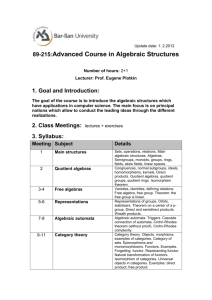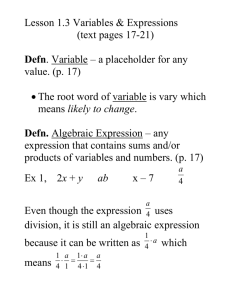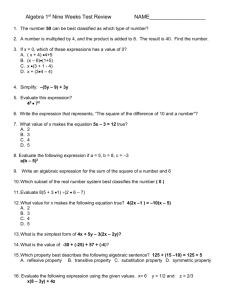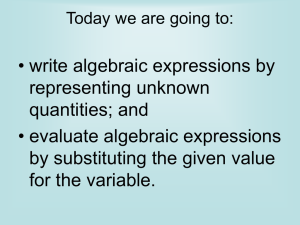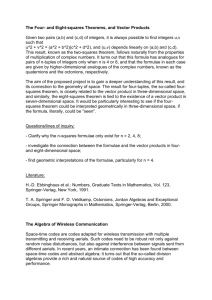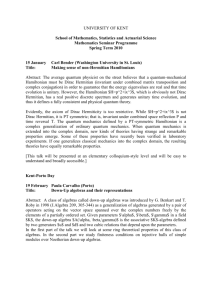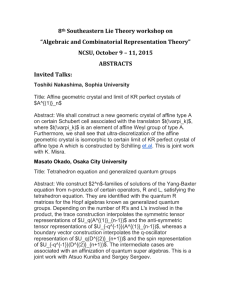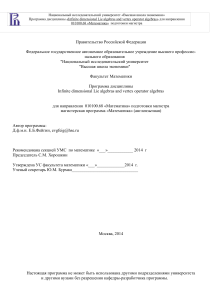Dioids and Nano
advertisement
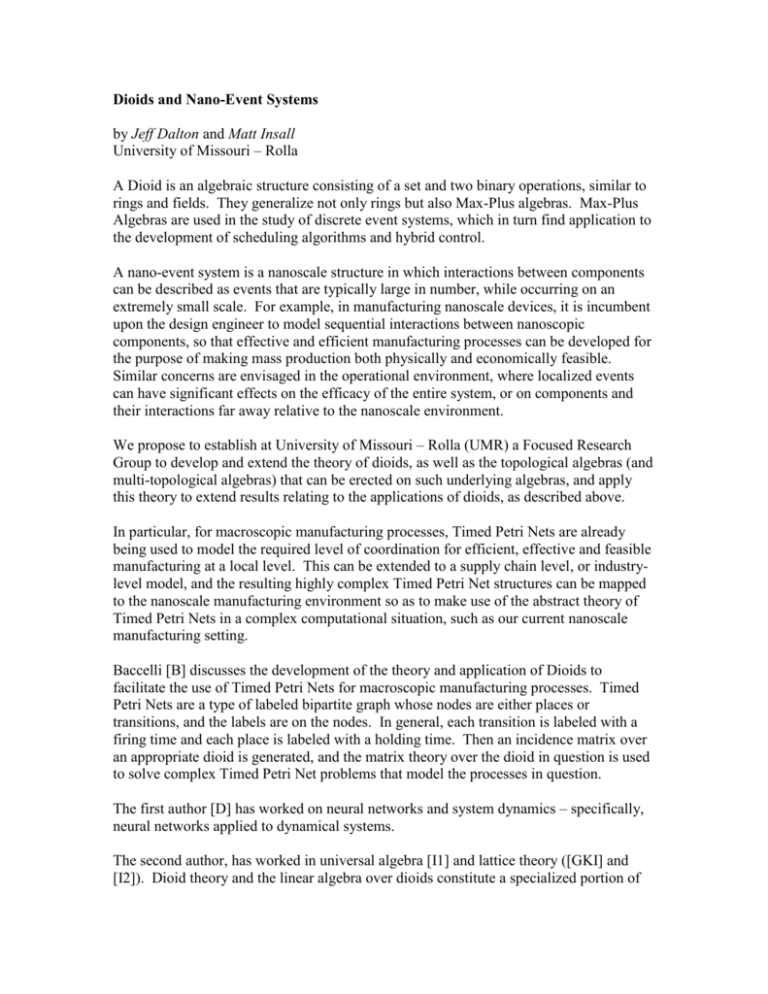
Dioids and Nano-Event Systems by Jeff Dalton and Matt Insall University of Missouri – Rolla A Dioid is an algebraic structure consisting of a set and two binary operations, similar to rings and fields. They generalize not only rings but also Max-Plus algebras. Max-Plus Algebras are used in the study of discrete event systems, which in turn find application to the development of scheduling algorithms and hybrid control. A nano-event system is a nanoscale structure in which interactions between components can be described as events that are typically large in number, while occurring on an extremely small scale. For example, in manufacturing nanoscale devices, it is incumbent upon the design engineer to model sequential interactions between nanoscopic components, so that effective and efficient manufacturing processes can be developed for the purpose of making mass production both physically and economically feasible. Similar concerns are envisaged in the operational environment, where localized events can have significant effects on the efficacy of the entire system, or on components and their interactions far away relative to the nanoscale environment. We propose to establish at University of Missouri – Rolla (UMR) a Focused Research Group to develop and extend the theory of dioids, as well as the topological algebras (and multi-topological algebras) that can be erected on such underlying algebras, and apply this theory to extend results relating to the applications of dioids, as described above. In particular, for macroscopic manufacturing processes, Timed Petri Nets are already being used to model the required level of coordination for efficient, effective and feasible manufacturing at a local level. This can be extended to a supply chain level, or industrylevel model, and the resulting highly complex Timed Petri Net structures can be mapped to the nanoscale manufacturing environment so as to make use of the abstract theory of Timed Petri Nets in a complex computational situation, such as our current nanoscale manufacturing setting. Baccelli [B] discusses the development of the theory and application of Dioids to facilitate the use of Timed Petri Nets for macroscopic manufacturing processes. Timed Petri Nets are a type of labeled bipartite graph whose nodes are either places or transitions, and the labels are on the nodes. In general, each transition is labeled with a firing time and each place is labeled with a holding time. Then an incidence matrix over an appropriate dioid is generated, and the matrix theory over the dioid in question is used to solve complex Timed Petri Net problems that model the processes in question. The first author [D] has worked on neural networks and system dynamics – specifically, neural networks applied to dynamical systems. The second author, has worked in universal algebra [I1] and lattice theory ([GKI] and [I2]). Dioid theory and the linear algebra over dioids constitute a specialized portion of these two areas (Dioid theory that involves max-plus algebras is concerned with ordered algebraic structures, rather than merely algebraic structures. Lattices are ordered algebraic structures.) As we stated above, we also plan to study the topological algebraic aspects of Dioid theory, and the second author has done work in topology as well, in connection to his research in lattice theory [GKI] and in connection to his work in nonstandard methods [I3], as well as metric space theory [I4]. References [B] F. Baccelli, Synchronization and Linearity: An Algebra for Discrete Event Systems. Wiley, 1992. [D] J. Dalton, A Critic Based System for Neural Guidance and Control, Ph.D. Dissertation, Univ. of MO – Rolla. 1994. [GKI] M. Gehrke, K. Kaiser, M. Insall, ``Some Nonstandard Methods Applied to Distributive Lattices'', in Zeitschrifte fur Mathematishe Logik und Grundlagen der Mathematik 36(1990), pages 123 to 131. [I1] M. Insall, ``Nonstandard Methods and Finiteness Conditions in Algebra’’, in Zeitschr. fur Mathe. Logik und Grundlagen der Mathematik 37 (1991), pages 525 to 532. [I2] M. Insall, ``Some Finiteness Conditions in Lattices - Using Nonstandard Proof Methods'', in J. of the Austr. Math. Soc. 53(1992), pages 266 to 280. [I3] M. Insall, ``Hyperalgebraic Primitive Elements for Relational Algebraic and Topological Algebraic Models'', in Studia Logica 57(1996), pages 409 to 418. [I4] M. Insall, ``Point-Valued Mappings of Sets'', Intern. J. of Math. and Math. Sci., vol. 18, No. 4(1995), pages 819 to 822.


